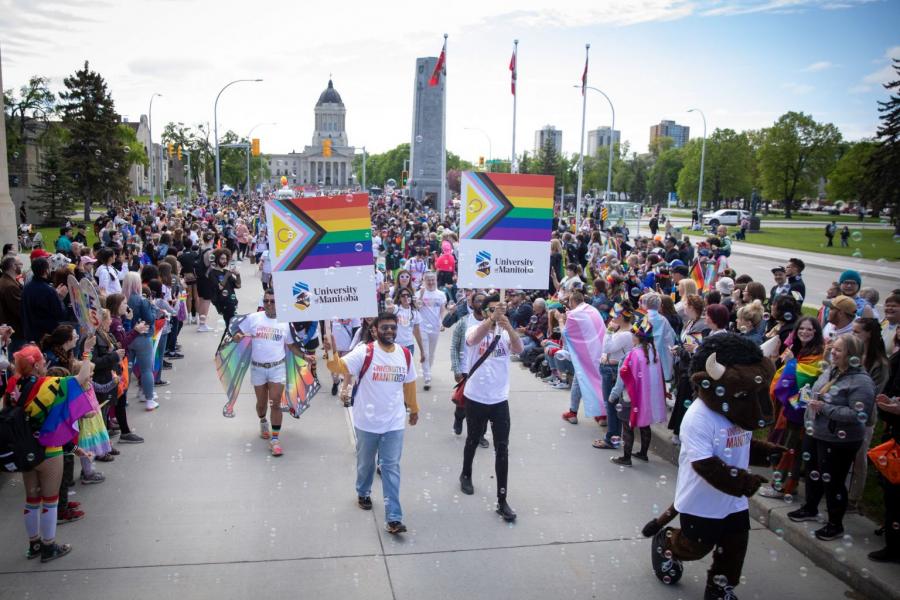Kagowa Kuruneri
Director, equity, access and participation
kagowa.kuruneri@umanitoba.ca
Equity, access and participation
The Rady Faculty of Health Sciences promotes and supports a community that embraces equity, access and participation, provides for equality of opportunity and recognizes the dignity of all people. These are key values to create an inclusive community for all.
On this page
Use the links below to jump to the section you're looking for:
About Our transformational change
Discrimination in the learning and work environment can be mitigated only through a formal change management process that leads to change that is institutionally transformational.
The change of the office name is the beginning of a formal change management process with the ultimate goal: a faculty that is free of racism, ableism, sexism, homophobia and transphobia. The focus of our unit - equity, access and participation - is on people not concepts that don’t work for us.
Equity is fairness and provides resources that focus on the specific needs of communities and the individuals within them. At the same time, equity strives to identify and eliminate systemic barriers that marginalized groups have historically and currently face.
Access to resources is a fundamental principle of social justice that ensures all students, faculty, and staff can take advantage of the opportunities the Faculty has to offer.
Participation to uphold social justice requires that individuals have the opportunity and platform to participate in making the policies that affect their well-being.
This includes disrupting the invisible belief that Whiteness is the normal against all which is compared. The goals of the Office of Equity, Access and Participation are to center humanity, justice, and dismantling systems of racism, inequity and oppression in all forms with a focus on decentering “Whiteness” in our approach.
Equity, access and participation reflects our goals:
- To redistribute power to enhance the well-being of individuals through equity, access and participation.
- Equity concerns focus more on changing the structures and systems that create the inequities in the first place.
We know there is significant underrepresentation of Indigenous Peoples, Black and racially marginalized persons, persons with a disability in our faculty and staff. This is a signal that these systemically excluded groups continue to face barriers to equity, access and participation.
We need to actively dismantle these systems of oppression in our faculty. This will demand approaches that are bold, transformational, adaptive, and systemic.
Participation aims to center underrepresented voices and experiences, recognize the historical underpinnings of the systemic barriers in medicine, and explicitly address and dismantle these in all functional areas of Rady Faculty of Health Sciences.
To view the Rady Faculty of Health Sciences' policy on Equity, Diversity and Inclusion, please visit the policy page.
Resources
- Acclaimed scholar Ibram X. Kendi explains how to be an antiracist
- The five principles of social justice
- The problems with modern day “diversity and inclusion”
- The trouble with inclusion
- How to uphold white supremacy by focusing on diversity and inclusion
- How to dismantle white supremacy
- Diversity, equity and inclusion have failed. How about belonging, dignity and justice instead?
Our commitment to reconciliation
The Rady Faculty of Health Sciences acknowledges its location on Treaty 1 Territory and obligation to provide service to diverse Indigenous communities. We are committed to implementing the Calls to Action, and pledge to further the Principles of Reconciliation from the Truth and Reconciliation Commission of Canada.
These efforts are detailed in the Rady Faculty of Health Sciences Reconciliation Action Plan, led by Ongomiizwin, the Indigenous Institute of Health and Healing.
Equity, Access and Participation Committee
The Equity, Access and Participation Committee acts as the main discussion and advisory body of the Rady Faculty of Health Sciences in relation to issues of equity, access and participation.
Terms of reference
1 PURPOSE AND MANDATE
1.1 Purpose/Mandate: The Equity, Diversity and Inclusion Committee (“Committee”) of the Rady Faculty of Health Sciences (“RFHS”) is established to act as the main discussion and advisory body of the RFHS in relation to issues of equity, diversity and inclusion (i.e., its “Mandate”). Equity, diversity and inclusion are concepts explained by actions intended to ensure that the University community (including its students, staff, faculty and leadership) is reflective of society served, including with regard to women, Indigenous peoples, persons with disabilities, and members of racialized communities, as well as other historically under-represented groups such as 2SLGBTQIA+, refugee and immigrant groups as well as others.
NOTE: “2SLGBTQIA+” is an acronym describing sexual and gender minority communities namely the two-spirit, transgender, lesbian, gay, bisexual, queer and questioning community. The “+” recognizes the diversity of identities and represents many more sexual orientations and gender identities not captured within the acronym.
1.2 Rationale for Committee Formation: The RFHS seeks to maintain and further incorporate concepts of equity, diversity and inclusion into its learning and working environments so as to better reflect society served, thereby improving upon health care education and service.
1.3 Clarification of Jurisdiction: This Committee is intended to complement other University resources and efforts aimed at addressing matters related to equity, diversity and inclusion and to foster collaboration on equity, diversity and inclusion within the RFHS. This Committee is not intended to act as a substitute, duplicate or alternate forum to address issues over which other areas of the University have specific jurisdiction and mandates. For example, issues coming within the University’s Respectful Work and Learning Environment Policy are intended to be addressed by the University’s Office of Human Rights and Conflict Management.
1.4 Statements Regarding the Special Status Held by Indigenous Peoples: This Committee respects the special status held by Indigenous peoples. This Committee respects the RFHS Reconciliation Action Plan.
2 REPORTING AND ACCOUNTABILITY
2.1 Accountability: The Committee is advisory to and accountable to the RFHS Dean (“Dean”) and Vice-Provost
(Health Sciences) (“Vice-Provost”).
2.2 Reporting: The Committee, through the Chair, shall provide a written report to the Dean and Vice-Provost once per calendar year.
CHAIRPERSON AND COMMITTEE MEMBERSHIP
2.3 Chair: The Committee Chair or Co-Chairs (i.e., the “Chair”) shall be appointed by the Dean and Vice-Provost.
The Chair is responsible for the following at Committee meetings:
a) Calling the meeting to order;
b) Establishing an agenda and ensuring agenda items are addressed;
c) Ensuring the minutes from prior meeting(s) are reviewed and approved by the Committee (with or without modification);
d) Facilitating discussion to reach consensus on matters under consideration in a professional manner. If consensus cannot be reached, the varying recommendations for resolution will be presented by the Chair to the Dean and Vice-Provost;
e) Adjourning meetings after business is concluded; and f) Acting as the main representative of the Committee.
3.2 Membership: The Committee membership may consist of up to twenty-seven (27) members, including the
Chair, comprised of the following:
a) Up to four (4) representatives from each of the RFHS Colleges, as confirmed by the RFHS Dean & Vice- Provost, for a total maximum of twenty (20) members, ensuring that each RFHS College appoints a minimum of one Faculty member, one administrative support staff member, and one student/learner;
b) Up to two (2) representatives from Ongomiizwin (Clearing a path for generations to come), Institute of
Health and Healing. Such member(s) will be appointed by the RFHS Vice-Dean, Indigenous Health;
c) One (1) representative from the RFHS WISDOM (Women In Science, Development, Outreach and Mentorship) Committee, as determined by the RFHS WISDOM Committee; and
d) Up to five (5) representatives from the University service community, as appointed by the Dean and Vice- Provost. Such members may include representatives from the offices of Indigenous Achievement, Human Resources (e.g., Diversity and Inclusion), Human Rights and Conflict Management, Legal Counsel, and Health Sciences Libraries.
3.3 Diversity of Membership: The RFHS strives to achieve diverse membership on its committees that is reflective of its commitment to diversity and inclusion and this should be considered in the appointment of Committee members.
3.4 Liaisons: Committee members shall serve as liaison persons with others in the areas from which they are appointed.
3.5 Consultation: In carrying out its role, the Committee may call upon various resources as it deems required, including, consultation with University legal counsel and the Manitoba Fairness Commissioner.
3 TERM OF OFFICE
3.1 The term of office of each Committee member shall be until the first of the following occurs:
a) the individual no longer holds the position noted in 3.2;
b) the term of the appointment ends;
c) the appointment is rescinded by the appointer; or d) the individual resigns from the Committee.
4 FUNCTIONS AND ACTIVITIES OF COMMITTEE
4.1 As part of its Mandate, the Committee will determine issues of priority and make recommendations to the Dean and Vice-Provost. The Committee may refer work requiring review, collaboration and analysis to Committee Working Groups (as detailed below).
5 MEETINGS
5.1 Number of Meetings: The Committee shall meet three (3) times per academic year, or subject to the call of the Chair.
5.2 Notice of Meetings: Notice of a Committee meeting and the item(s) for discussion must be provided to Committee members, at five (5) business days in advance of the meeting, unless waived by the Committee members at the meeting.
5.3 Agenda: Agenda items should be sent to the Committee Chair at least 48 hours in advance of the meeting.
The agenda should be prepared and distributed to the members of the Committee prior to the meeting.
5.4 Quorum: As the Committee is mainly a discussion and advisory group, a quorum is not required to hold a meeting.
5.5 Decision-Making: The preferred model for decision-making is consensus. If consensus cannot be reached, the varying recommendations for resolution will be presented by the Chair to the Dean and Vice-Provost for decision.
5.6 Committee Meeting Guests: All Committee meetings will be limited to members only unless the Chair otherwise grants approval for certain individuals to attend all or a portion of the meeting.
5.7 Telephone Meetings and Email Discussion: The Chair may consult with Committee members by email or arrange telephone meetings, instead of in-person meetings, as the circumstances may require.
5.8 Confidentiality: All Committee members, resource persons, consultants, guests, and administrative support persons who may be in attendance at a Committee meeting or privy to Committee information, are required to protect and keep confidential any protected information (e.g., classified or privileged information) received through participation on the Committee, unless such information is otherwise approved for public information.
5.9 Minutes & Confidentiality: Minutes are to be taken of business occurring during Committee meetings.
However, the Committee may move “in camera” to deal with certain items if the subject matter being considered relates to personal and confidential matters that are exempt from disclosure under applicable access and privacy laws and University policies. Once approved by the Committee, meeting minutes shall be publicly available, in accordance with applicable access and privacy laws and University policies.
6 COMMITTEE ADMINISTRATIVE SUPPORT
6.1 The Committee Chair shall receive administrative support from the RFHS. The administrative support shall be provided through an individual whose duties shall include:
a) Assisting the Chair with preparation of Committee meeting agendas and distributing notification of meetings;
b) Ensuring follow-up of Committee action items;
c) Information gathering;
d) Preparation and distribution of meeting material;
e) Minute-taking; and
f) Maintaining Committee records.
7 WORKING GROUPS
7.1 Referral to Working Groups: The Committee may refer equity, diversity and inclusion issues of priority, requiring review, collaboration and analysis, to one or more Working Groups, which may be College specific, as the circumstances require (e.g., review of College policies to meet accreditation requirements for equity, diversity and inclusion).
7.2 Working Group Leads: Each Working Group shall have one or more leads (“Leads”), as appointed by the Committee Chair, in consultation with the Committee. The Lead need not necessarily be a Committee member.
7.3 Lead Consultation with Committee Chair: Leads shall consult with the Committee Chair in clarifying the parameters and timelines associated with assigned work. The Committee Chair will consult with the Committee as may be required in order to clarify parameters and timelines with the Leads.
7.4 Working Group Reporting: The Leads shall provide the Committee Chair with periodic updates of the Working Group work and progress and shall provide a final report to the Committee Chair at the completion of the Working Group’s work. The Committee Chair will consult with the Committee and report to the Dean and Vice-Provost on Working Group work.
7.5 Working Group Membership: The Lead of each Working Group shall recruit the membership they deem necessary to carry out the assigned work. The Lead shall bear in mind the RFHS commitment to equity, diversity and inclusion when recruiting Working Group members.
7.6 Working Group Terms of Reference: In addition to the above provisions on Working Groups:
a) The terms of office for each Working Group member shall be for the duration of the assigned work unless the member resigns or the term is earlier rescinded by the appointing Lead.
b) The Lead shall assume the same responsibilities as the Chair for the Working Group (i.e., in terms of leading meetings, facilitating discussion, ensuring assigned work is completed as required);
c) The above provisions dealing with Committee Meetings shall apply to Working Group meetings, except that the number of meetings shall be as determined by the Lead.
8 AMENDMENTS TO TERMS OF REFERENCE
8.1 Amendments to these Terms of Reference may be proposed by the Committee to the RFHS Deans’ Council for approval.
9 DATES OF APPROVAL, REVIEW AND REVISION
9.1 Date approved: April 28, 2020
9.2 Review: Formal review of these terms will be conducted every ten (10) years. In the interim these terms may be revised or rescinded if the Dean and Vice-Provost deems necessary
9.3 Supersedes: RFHS Dean’s Council – Tuesday, May 1, 2018; RFHS Deans’ Council - Tuesday, February 6, 2018
9.4 Committee Administrative Support: Equity, Diversity, Inclusion Co-Ordinator
9.5 Effect on Previous Statements: These terms shall supersede all previous Rady Faculty of Health Sciences and its Colleges terms on the subject matter herein.
Commitment letter
The commitment letter is available in an alternate format upon request to RadyEquity@umanitoba.ca.
Record of decisions
2021
2020
2018
2017
All record of decisions documents are available in alternate formats upon request. Contact RadyEquity@umanitoba.ca.
Equity, Diversity, Inclusion, Accessibility (EDIA) Community of Practice
This community of practice gathers to discuss practical theoretical issues related to advancing equity, diversity, inclusion and accessibility at the University of Manitoba and beyond.
To learn more or to join the monthly 90-minute discussion, visit the UM Equity, Diversity, Inclusion, Accessibility (EDIA) Community of Practice webpage.
You may also want
Days of significance
To enhance our knowledge and create a shared understanding of our community the following calendar contains cultural, religious, national, and international Days of Significance. This is a living calendar; some dates will change from year to year according to various religious and/or cultural calendars.
Contact us
-
-
Israel Agada (Jake)
Project coordinator, equity, access and participation
israel.agada@umanitoba.ca
Equity, access and participation
Rady Faculty of Health Sciences
467 Chown Building, 753 McDermot Avenue
University of Manitoba (Bannatyne Campus)
Winnipeg, Manitoba R3E 0W3



